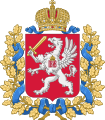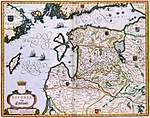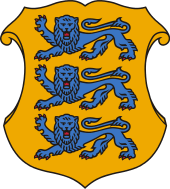Governorate of Livonia
The Governorate of Livonia[1] (Russian: Лифляндская губерния, romanized: Lifljandskaja gubernija; German: Livländisches Gouvernement; Latvian: Vidzemes guberņa, after the Latvian inhabited Vidzeme region; Estonian: Liivimaa kubermang) was one of the Baltic governorates of the Russian Empire, now divided between Latvia and Estonia.
| Governorate of Livonia Livländisches Gouvernement Лифля́ндская губе́рния | |||||||||||
|---|---|---|---|---|---|---|---|---|---|---|---|
| Governorate of the Russian Empire | |||||||||||
| 1721–1918 | |||||||||||
 Coat of arms
| |||||||||||
 | |||||||||||
| Capital | Riga | ||||||||||
| Population | |||||||||||
• (1897) | 1,299,365 | ||||||||||
| History | |||||||||||
• Established (de facto) | 28 July 1713 | ||||||||||
• Established (de jure) | 10 September 1721 | ||||||||||
• Renamed | 1796 | ||||||||||
• Divided | 12 April 1917 | ||||||||||
| 3 March 1918 | |||||||||||
• Disestablished | 12 April 1918 | ||||||||||
| Political subdivisions | 9 | ||||||||||
| |||||||||||
| Today part of | |||||||||||

History
_Befehl_i._J._1783.jpeg)
Following the capitulation of Estonia and Livonia in 1710, Peter the Great, on July 28, 1713, created the Riga Governorate (Russian: Рижская губерния) which also included Smolensk Uyezd, Dorogobuzh Uyezd, Roslavl Uyezd and Vyazma Uyezd of Smolensk Governorate. Smolensk Province was created from territory in Smolensk Governorate at that time. It was incorporated into Smolensk Governorate when it was reformed in 1726.
Sweden formally ceded Swedish Livonia to Russia in 1721 with the Treaty of Nystad. In 1722 Dorpat County was added to Riga Governorate. In 1726 Smolensk Governorate was separated from Governorate, which now had five provinces: Riga, Wenden, Dorpat, Pernau and Ösel. In 1783 the Schlock County was added. On July 3, 1783 Catherine the Great reorganized Governorate into Riga Viceroyalty. Only in 1796, after the Third Partition of Poland this territory was renamed as the Governorate of Livonia.
Until the late 19th century the governorate was not ruled by Russian laws but was administered autonomously by the local German Baltic nobility through a feudal Landtag (Liefländischer Landtag).[2] German nobles insisted on preserving their privileges and use of the German language. In 1816 Tsar Alexander liberated the serfs of Livonia, in a precursor to his plans for the rest of Russia.[3]
After the Russian February Revolution in 1917, the northern part of the Governorate of Livonia was combined with the Governorate of Estonia to form a new Autonomous Governorate of Estonia. The Autonomous Governorate of Estonia issued the Estonian Declaration of Independence on 24 February 1918, one day before it was occupied by German troops during World War I.
With the Treaty of Brest-Litovsk on 3 March 1918, Bolshevik Russia accepted the loss of the Livland Governorate and by agreements concluded in Berlin on 27 August 1918, the Autonomous Governorate of Estonia and the Governorate of Livonia were severed from Russia.[4]
Administrative division
The Governorate of Livonia was divided into 9 counties (Kreis).
| # | County | County city (pop.) | Area, sq versts |
Population[5] |
|---|---|---|---|---|
| 1 | Kreis Walk | Walk (10,922) | 5298.7 | 120,585 |
| 2 | Kreis Wenden | Wenden (6,356) | 4953.7 | 124,208 |
| 3 | Kreis Werro | Werro (4,152) | 3744.2 | 97,185 |
| 4 | Kreis Wolmar | Wolmar (5,050) | 4358.1 | 112,836 |
| 5 | Kreis Pernau | Pernau (12,898) | 4694.9 | 98,123 |
| 6 | Kreis Riga | Riga (282,230) | 5468.4 | 396,101 |
| 7 | Kreis Fellin | Fellin (736) | 4015.2 | 99,747 |
| 8 | Kreis Ösel | Arensburg (4,603) | 2515.5 | 60,263 |
| 9 | Kreis Dorpat (Yuryev) | Dorpat (Yuryev) (42,308) | 6276.7 | 190,317 |
Note: After the February Revolution based on declaration of the Russian Provisional Government of 30 March 1917 "About the autonomy of Estland", the Government of Livland was divided: five northern counties (Kreis) with the Estonian population (Dorpat, Pernau, Fellin, Werro and Ösel) as well as the populated by the Estonians townships of Walk county were all included into the composition of the neighboring Governorate of Estonia. However the new border between the Governments of Estonia and Livland was never properly demarcated.
Part of a series on the |
|---|
| History of Latvia |
 |
|
Ancient Latvia
|
|
Modern Latvia
|
| Chronology |
|
|
Part of a series on the |
|---|
| History of Estonia |
 |
|
|
Medieval Estonia
|
|
Modern Estonia
|
| Chronology |
|
|
Languages
- By the Imperial census of 1897.[5] In bold are languages spoken by more people than the state language.
| Language | Number | percentage (%) | males | females |
|---|---|---|---|---|
| Latvian | 563,929 | 43.4 | 271,215 | 292,714 |
| Estonian | 518,594 | 39.91 | 247,348 | 271,246 |
| German | 98,573 | 7.58 | 44,770 | 53,803 |
| Russian | 68,124 | 5.24 | 38,844 | 29,280 |
| Yiddish | 23,728 | 1.82 | 12,189 | 11,539 |
| Polish | 15,132 | 1.16 | 8,321 | 6,811 |
| Lithuanian | 6,594 | 0.5 | 4,131 | 2,463 |
| Persons that did not name their native language |
154 | >0.1 | 71 | 83 |
| Other[6] | 4,537 | 0.34 | 3,109 | 1,428 |
| Total | 1,299,365 | 100 | 629,992 | 669,373 |
List of governors
Riga Governor
- 1710 – 1713 Prince Aleksandr Danilovich Menshikov
- 1713 – 1719 Prince Pyotr Alekseyevich Golitsyn
- 1719 – 1726 Prince Anikita Ivanovich Repnin
- 1726 Herman Jensen Bohn
- 1726 – 1729 Grigori Petrovich Chernyshev
- 1729 – 1740 Count Peter von Lacy
- 1740 Ludolf August von Bismarck
- 1740 – 1758 vacant
- 1758 – 1761 Prince Vladimir Petrovich Dolgorukov
- 1761 – 1762 Yakov Stepanovich Arshenevsky
- 1762 – 1782 vacant
- 1782 – 1783 Ivan Alfereyevich Pil
Ruler of the Riga Governorship
- 1783 – 1789 Aleksandr Andreyevich Bekleshov
- 1789 – 1791 Johann von Reck
- 1791 – 1795 Baron Peter Ludwig von der Pahlen
- 1795 – 1796 Baron Gerhard Konrad Kasimir von Meyendorff
Governor of Livonia
- 1797 Baron Balthasar von Campenhausen
- 1797 Count Ernst Burchard von Mengden
- 1797 – 1808 Christoph Adam von Richter
- 1808 – 1811 Ivan Nikolayevich Repyev
- 1811 – 1827 Joseph Du Hamel
- 1827 – 1829 Baron Paul Theodor von Hahn
- 1829 Johann Ludwig Ferdinand von Cube (acting governor)
- 1827 – 1847 Baron Georg Friedrich von Fölkesahm
- 1847 Johan Ludwig Ferdinand von Cube (acting governor)
- 1847 – 1862 Heinrich Magnus Wilhelm von Essen
- 1862 – 1868 August Georg Friedrich von Oettingen
- 1868 – 1871 Friedrich Woldemar von Lysander
- 1871 – 1872 Julius Gustav von Cube (acting governor)
- 1872 – 1874 Baron Mikhail Egorovich Vrangel
- 1874 – 1882 Baron Alexander Karl Abraham von Uexküll-Güldenband
- 1882 – 1885 Ivan Egorovich Shevich
- 1885 Hermann Friedrich Johannes von Tobiesen (acting governor)
- 1885 – 1895 Mihail Alekseyevich Zinoviev
- 1895 – 1896 Aleksandr Nikolayevich Bulygin (acting governor)
- 1896 – 1900 Vladimir Dmitrievich Surovtsev
- 1900 – 1901 Aleksandr Nikolayevich Bulygin (acting governor)
- 1901 – 1905 Mikhail Alekseyevich Pashkov
- 1905 Pyotr Petrovich Neklyudov (acting governor)
- 1905 Yakov Dmitrievich Bologovsky (acting governor)
- 1905 – 1914 Nikolai Aleksandrovich Zvegintsov
- 1914 – 1916 Arkady Ippolitovich Kelepovsky
- 1916 Sergei Sergeyevich Podolinsky (acting governor)
- 1916 – 1917 Nikolai Nikolayevich Lavrinovsky
- 1917 Sergei Alekseyevich Shidlovsky
See also
- Administrative divisions of Russia in 1713-1714
- Baltic governorates
- Courland Governorate
- Estonia Governorate
- Livonian Confederation
References
- The Baltic States from 1914 to 1923 By LtCol Andrew Parrott Archived 19 March 2009 at the Wayback Machine
- Smith, David James (2005). The Baltic States and Their Region. Rodopi. ISBN 978-90-420-1666-8.
- Sebag Montefiore, Simon (2016). The Romanovs. United Kingdom: Weidenfeld & Nicolson. pp. 323–324.
- Hiden, John (2002). The Baltic States and Weimar Ostpolitik. Cambridge University Press. ISBN 9780521893251.
- Language Statistics of 1897 Archived 22 June 2011 at the Wayback Machine (in Russian)
- Languages, number of speakers which in all gubernia were less than 1000
 |
 |